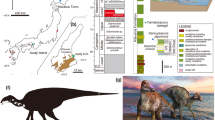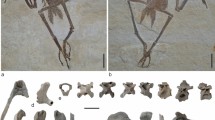Abstract
A new mammal family, Olseniidae, is proposed based on a complete foot skeleton of cf. Olsenia sp. from the Eocene Toru Ajgyr locality in Kyrgyzstan and an astragalus of Olsenia mira from the Eocene Shara Murun locality in northern China. The new form cf. Olsenia sp. is an early ungulate that combines characteristics of mesonychids, perissodactyls and artiodactyls: tetradactyl and paraxonic foot, terminal phalanges claw-like but not fissured, astragalus with shallow proximal caput and without distal trochlea. This unique character set fills a gap in the fossil record and gives insights into the ungulate phylogeny, which is still not completely understood.



Similar content being viewed by others
References
Archibald JD (1998) Archaic ungulates (“Condylarthra”). In: Janis CM, Scott KM, Jacobs LL (eds) Evolution of Tertiary mammals of North America, vol 1. Cambridge University Press, Cambridge, pp 292–329
Colbert EH (1934) Chalicotheres from Mongolia and China in the American Museum. Bull Am Mus Nat Hist 67:353–387
Dobberstein J, Hoffmann G (1961) Lehrbuch der vergleichenden Anatomie der Haustiere. Bewegungsapparat, vol 1, 2nd edn. Hirzel, Leipzig
Erfurt J (2000) Rekonstruktion des Skelettes und der Biologie von Anthracobunodon weigelti (Artiodactyla, Mammalia) aus dem Eozän des Geiseltales. Hallesches Jahrb Geowiss B Beiheft 12:57–141
Erfurt J, Averianov AO, Buchantschenko J, Fortuna AB (1999) Rediscovery of the Eocene mammal site Toru Aygyr (Kyrgyzstan). Hallesches Jahrb Geowiss B 21:107–127
Gatesy J, Milinkovitch M, Waddell V, Stanhope M (1999) Stability of cladistic relationships between Cetacea and higher-level artiodactyl taxa. Syst Biol 48:6–20
Geisler JH, Luo ZX (1998) Relationships of Cetacea to terrestrial ungulates and the evolution of cranial vaculature in Cete. In: Thewissen JGM (ed) The emergence of whales. Plenum, New York, pp 163–212
Gingerich PD, Uhen MD (1998) Likelihood estimation of the time of origin of Cetacea and the time of divergence of Cetacea and Artiodactyla. Palaeontol Electr 1:1–28
Gingerich PD, Haq Mu, Zalmout IS, Khan IH, Malkani MS (2001) Origin of whales from early artiodactyls: hands and feet of Eocene Protocetidae from Pakistan. Science 293:2239–2242
Hooker JJ, Dashzeveg D (2003) Evidence for direct mammalian faunal interchange between Europe and Asia near the Paleocene-Eocene boundary. Geol Soc Spec Paper 369:479–500
Linnaeus C (1758) Systema naturae per regna tria naturae, secundum classes, ordines, genera, species, cum characteribus, differentiis, synonymis, locis, vol 1, 10th edn. Laurentii Salvii, Stockholm
Madar SI, Thewissen JGM, Hussain ST (2002) Additional holotype remains of Ambulocetus natans (Cetacea, Ambulocetidae), and their implications for locomotion in early whales. J Vertebr Palaeontol 22:405–422
Madsen P, Scally M, Douady ChrJ, Kao DJ, DeBry RW, Adkins R, Amrine HM, Stanhope MJ, de Jong W, Springer MS (2001) Parallel adaptive radiations in two major clades of placental mammals. Nature 409:610–614
Matthew WD (1909) The Carnivora and Insectivora of the Bridger Basin, Middle Eocene. Mem Am Mus Nat Hist 9:289–567
Matthew WD (1915) A revision of the Lower Eocene Wasatch and Wind River faunas. Part I. Order Ferae (Carnivora). Suborder Creodonta. Bull Am Mus Nat Hist 34:4–103
Matthew WD (1929) Critical observations upon Siwalik mammals. Bull Am Mus Nat Hist 56:437–560
Matthew WD (1937) Paleocene faunas of the San Juan Basin, New Mexico. Trans Am Philos Soc 30:1–510
Matthew WD, Granger W (1925) New mammals from the Shara Murun Eocene of Mongolia. Am Mus Nov 196:1–11
Matthew WD, Granger W (1926) Two new perissodactyls from the Arshanto Eocene of Mongolia. Am Mus Nov 208:1–5
McKenna MC, Bell SK (1997) Classification of mammals. Columbia University Press, New York
O’Leary MA, Geisler JH (1999) The position of cetacea within mammalia: phylogenetic analysis of morphological data from extinct and extant taxa. Syst Biol 48:455–490
Osborn HF (1929) The titanotheres of ancient Wyoming, Dakota, and Nebraska. Volume 2. US Geol Surv Monogr 55:703–953
Reshetov VYu (1979) Rannyetretichnyye tapiroobraznyye Mongolii i SSSR (Early Tertiary tapiromorphs of Mongolia and USSR). Trudy Sovmestnoi Sov-Mong Paleontol Eksped 11:1-143
Rose KD (1987) Climbing adaptation in the Early Eocene Mammal Chriacus and the origin of Artiodactyla. Science 236:314–316
Rose KD (1990) Postcranial skeletal remains and adaptations in Early Eocene mammals from the Willwood Formation, Bighorn Basin, Wyoming. In: Bown TM, Rose KD (eds) Dawn of the Age of Mammals. Geological Society of America, Boulder, Colo., pp 107–134
Rose KD (1996a) Skeleton of Early Eocene Homogalax and the origin of Perissodactyla. Paleovertebrata 25:243–260
Rose KD (2001) Compendium of Wasatchian mammal postcrania from the Willwood Formation of the Bighorn Basin. Univ Mich Papers Paleontol 33:157–183
Scott WB (1886) Some new and little known creodonts. J Acad Nat Sci Philadelphia 9:155–185
Shimamura M, Abe H, Nikaido M, Ohshima K, Okada N (1999) Genealogy of families of SINEs in cetaceans and artiodactyls. Mol Biol Evol 16:1046–1060
Starck D (1979) Vergleichende Anatomie der Wirbeltiere, vol 2. Springer, Berlin Heidelberg New York
Szalay FS, Gould SJ (1966) Asiatic Mesonychidae (Mammalia, Condylarthra). Bull Am Mus Nat Hist 132:127–174
Thewissen JGM, Williams EM, Roe LJ, Hussain ST (2001) Skeletons of terrestrial cetaceans and the relationship of whales to artiodactyls. Nature 413:277–281
Xu Yuxuan (1966) Amynodonts of Inner Mongolia. Vertebr PalAsiat 10:123–190
Acknowledgements
The authors are grateful to Dr. Alla B. Fortuna and Prof. Aker T. Turdukulov from the Seismological Institute Bishkek for their support in the organisation of the fieldwork as well as to Juri Buchantschenko and Thomas Knebel, University Halle, for their help during the excavation; to Prof. Kenneth D. Rose, John Hopkins University, Baltimore, and Prof. Ian Lerche, University of South Carolina, for comments and proofreading of the English text; to three unknown reviewers for their useful comments; to Angelika Franke, Halle, for the drawings. The expeditions have been supported by the German Science Foundation (Erf 197/3-3)
Author information
Authors and Affiliations
Corresponding author
Rights and permissions
About this article
Cite this article
Erfurt, J., Averianov, A. Enigmatic ungulate-like mammals from the Eocene of Central Asia. Naturwissenschaften 92, 182–187 (2005). https://doi.org/10.1007/s00114-004-0605-x
Received:
Accepted:
Published:
Issue Date:
DOI: https://doi.org/10.1007/s00114-004-0605-x




